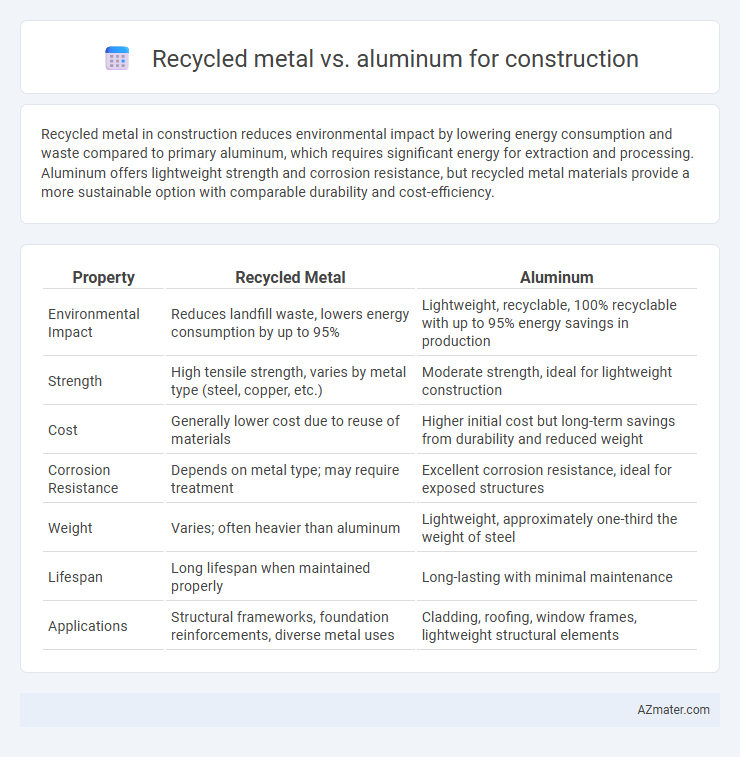Recycled metal in construction reduces environmental impact by lowering energy consumption and waste compared to primary aluminum, which requires significant energy for extraction and processing. Aluminum offers lightweight strength and corrosion resistance, but recycled metal materials provide a more sustainable option with comparable durability and cost-efficiency.
Table of Comparison
| Property | Recycled Metal | Aluminum |
|---|---|---|
| Environmental Impact | Reduces landfill waste, lowers energy consumption by up to 95% | Lightweight, recyclable, 100% recyclable with up to 95% energy savings in production |
| Strength | High tensile strength, varies by metal type (steel, copper, etc.) | Moderate strength, ideal for lightweight construction |
| Cost | Generally lower cost due to reuse of materials | Higher initial cost but long-term savings from durability and reduced weight |
| Corrosion Resistance | Depends on metal type; may require treatment | Excellent corrosion resistance, ideal for exposed structures |
| Weight | Varies; often heavier than aluminum | Lightweight, approximately one-third the weight of steel |
| Lifespan | Long lifespan when maintained properly | Long-lasting with minimal maintenance |
| Applications | Structural frameworks, foundation reinforcements, diverse metal uses | Cladding, roofing, window frames, lightweight structural elements |
Introduction to Sustainable Construction Materials
Recycled metal and aluminum are integral to sustainable construction materials, offering reduced environmental impact compared to virgin resources. Recycled metal retains strength and durability while significantly lowering energy consumption and greenhouse gas emissions during production. Aluminum, prized for its lightweight and corrosion resistance, also benefits from high recyclability, making it a cornerstone in eco-friendly building projects.
Overview of Recycled Metal in Construction
Recycled metal in construction offers a sustainable alternative by repurposing scrap steel, iron, and other metals, significantly reducing environmental impact and conserving natural resources. It exhibits high strength, durability, and corrosion resistance, making it ideal for structural frameworks, roofing, and reinforcement applications. The use of recycled metal also lowers production energy consumption by up to 75% compared to primary metal extraction, enhancing cost efficiency and promoting circular economy practices within the construction industry.
Aluminum: Properties and Common Uses
Aluminum is prized in construction for its lightweight nature, corrosion resistance, and excellent strength-to-weight ratio, making it ideal for structural components and cladding. Its versatility allows for efficient fabrication in windows, doors, roofing, and facades, contributing to energy-efficient and sustainable building designs. Recycled aluminum retains its properties while reducing environmental impact, supporting circular economy goals in construction materials.
Environmental Impact: Recycled Metal vs Aluminum
Recycled metal significantly reduces environmental impact by conserving natural resources and lowering energy consumption compared to primary aluminum production, which is highly energy-intensive. Aluminum recycling uses just 5% of the energy required to produce new aluminum, greatly minimizing greenhouse gas emissions. Incorporating recycled metals in construction promotes sustainable practices by reducing waste in landfills and decreasing the carbon footprint of building materials.
Structural Strength and Durability Comparison
Recycled metal, particularly steel, offers superior structural strength and durability compared to aluminum, making it ideal for load-bearing construction applications. Steel's high tensile strength and resistance to deformation provide enhanced stability in frameworks, while aluminum's lower density and corrosion resistance favor lightweight but less robust structural elements. Durability-wise, recycled steel maintains integrity under heavy stress and extreme weather conditions, whereas aluminum, though corrosion-resistant, may suffer from fatigue and reduced strength over prolonged heavy use.
Cost Analysis: Initial Investment and Lifecycle
Recycled metal typically offers lower initial investment costs compared to aluminum, due to reduced refining and processing expenses. Over the lifecycle, aluminum's durability and resistance to corrosion can result in lower maintenance and replacement costs, offsetting its higher upfront price. Factoring in energy consumption and longevity, recycled metals often achieve cost-efficiency through environmental savings and shorter payback periods in construction projects.
Energy Efficiency in Production
Recycled metal requires significantly less energy compared to producing aluminum from raw materials, reducing greenhouse gas emissions in construction projects. Aluminum production is highly energy-intensive due to the electrolysis process, whereas recycling aluminum can cut energy use by up to 95%. Choosing recycled metal enhances sustainability and lowers the carbon footprint in building material manufacturing.
Corrosion Resistance and Maintenance Needs
Recycled metal and aluminum differ significantly in corrosion resistance and maintenance needs for construction applications. Aluminum offers superior resistance to corrosion due to its natural oxide layer, reducing the need for frequent maintenance and protective coatings. Recycled metals, depending on their composition, often require additional treatments like galvanization or painting to prevent rust and corrosion, leading to higher maintenance over time.
Applications and Suitability in Modern Building Projects
Recycled metal offers exceptional durability and environmental benefits, making it ideal for structural frameworks and exterior cladding in modern building projects. Aluminum, lightweight and corrosion-resistant, suits applications like window frames, roofing, and curtain walls, enhancing energy efficiency and aesthetic flexibility. Both materials support sustainable construction goals, with recycled metal providing strength and aluminum delivering versatility in design and performance.
Future Trends: Innovations in Metal Construction Materials
Recycled metal is increasingly favored in construction due to its lower carbon footprint and enhanced durability, promoting sustainable building practices. Innovations in aluminum alloys focus on improving strength-to-weight ratios, corrosion resistance, and energy efficiency, contributing to advanced architectural designs and infrastructure longevity. Future trends highlight hybrid metal composites combining recycled metals and aluminum to optimize performance while reducing environmental impact in construction projects.

Infographic: Recycled metal vs Aluminum for Construction
 azmater.com
azmater.com